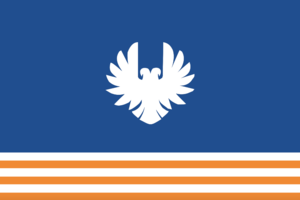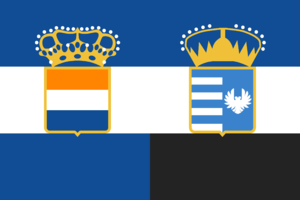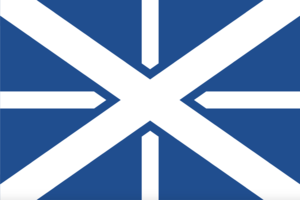Laveska
|
Federal Republic of Laveska
Федеративнаыа Республика Лавескаыа (Federativnaya Respublika Laveskaya)
|
|||||
|---|---|---|---|---|---|
| [[File:]] | |||||
| The six States of the Federacy governed by the Consular Phoenix and the Blue of the Seas. | |||||
| Motto | Ex Unitate Vires | ||||
| Common Name | Laveska | ||||
| Anthem | Дороги (Dorogi) | ||||
| Demonym | Laveskan | ||||
| Official languages | Aesori, Zeroan, Zokesian, Strelkan | ||||
| Politics | |||||
| Capital | Lavesk | ||||
| Government | Federal presidential constitutional republic | ||||
| Foundation | 1707 | ||||
| Consul | Khristianskiy Asimov | ||||
| Preceded by | Laveskan Seafarer's Republic | ||||
| Demography | |||||
| Ethnicities | Laveskan, Zeroan, Strelkan, Zokesian | ||||
| Population | 5,253,774 | ||||
| Area | 61,215 km² km² | ||||
Laveska, officially the Federal Republic of Laveska, is a prosperous nation of farms, ports, and mountains located in the western Wakir. Bordered by Tizca to the north, Maryurt to the west, Doren to the south, and Noland in the east, Laveska is a gateway to many cultures, nations, and resources. She consists of six Federal States, one self-governing colony, and one unincorporated territory under military administration. Mainland Laveska extends from the Larkuno Mountains to the Wakir Ocean and from the Feniks River to the Tizcan Mountains, while Overseas Laveska includes the Free City of Fortmil. The territories held by the Maryurti Emirate of Larkuno are under direct military occupation as of 2143.
Etymology
The name Laveska originates from the Eastern Aesori word Lavesk'ani, meaning "Eternal Fountain," referring to the Wakir Ocean. Though Eastern Aesori is a largely dead language now, due to the fact that the language was a brute-force combination of Old Aesori, Reciprocan, and Feguan, the name stuck and when a group of merchants established a major settlement on a peninsula bordering the Wakir Sea, they named the city Laveska, a shortening of her original name. As time went on and Laveska became less of a city and more of a state, the name became attached to the whole region north-west of Algiza.
Government
The Laveskan Federal Government consists of a tricameral legislature, the Senate which is voted in by the people every four years, and a Presidium of which half of its representatives are voted in by the people and the other half by state governments. There are not many parties but a variety does exist, and coalitions are necessary to maintain any reliable grasp on power. The third house is the Grand Syndicate, where trade unions send their representatives to the government. The Syndicate is independent of the Senate and Presidium, but has little power and can be overruled by a vote in either the Senate or Presidium. The executive consists of a pair of Consuls, one for internal affairs, and the second for foreign. The current IntAf Consul is Anatoliy Reva of the Union half of the Union-Mercantilist party, and the current ExtAf Consul is Khristianskiy Asimov of the Mercantile half of the Union-Mercantilist party. The High Court handles judicial matters, and the military is led by the Laveskan High Command, with the ExtAf consul at its head.
Each Outlying State gets 5 Presidents that it can send to the Presidium, with Lavesk getting 10 due to its central status in the Federation's creation. Presidents are elected by popular district, lending a total of 200 Senators and 70 Presidents as of 2144.
States
Laveska's current constitution grants its States a high level of autonomy, but strictly enforces the absolute nature of the rights granted to its people under the Constitution. Policing is done at the local level through federally-deputized people's militias, which themselves are organized into a union of militias, the Federatsiya Militsii, that can be rapidly mobilized in cases of war or national emergency. This allows the federal government to protect the rights of its citizens without having to micromanage each of its component areas.
Economy and Infrastructure
Laveska's economy depends almost entirely on its access to the sea. A network of so-called "transport highways," four-lane roads explicitly dedicated to shipping agencies and their transport vehicles were built by the naval junta in the 2040s, quickening the pace of global trade.
Northern Laveska, and to a lesser extent Southern Laveska, are known for their farming operations, providing food for the more mountainous regions of Laveska as well as some neighboring countries. Small farming communes are still very common in Laveska, often appearing near transport highways but not civilian ones. Food is exported en masse to the various Doren states south of Laveska, as well as the more barren Tizca to the north.
The urban areas of Laveska are notable for their employment of "Sotsgorod," the Arcadian Communist style of architecture. Due to the abject failure of the Communist system in Arcadia however, Laveskan Sotsgorod architecture was of far higher quality than its Arcadian counterpart. These cities eliminated the need for the suburbs, freeing up massive amounts of land for farming operations.
The coastal areas of Laveska are renowned for their industrial prowess, with shipbuilding at the forefront. Metals from western Laveska are shipped to the east using trains, lake freighters, or bulk carriers on the transport highways. Many of these metals, those that cannot be used by the manufacturing industry or those that are simply not needed, are shipped overseas. Laveskan ports are also important hubs of trade, with their vast facilities allowing for even the largest ships to be attended to in record time.
History
Ancient-Medieval History
Laveska was originally inhabited by the Reciprocan peoples, though not much is known about them other than that they were an offshoot of the Feguanesians. Starting in the 12th century, the Great Belasrii Empire began expanding eastward at a rapid pace, crossing the Larkuno Mountains in 1199. The Belasrii had far better technology including an early form of rocket artillery, and the Reciprocans stood no chance. The Belasrii army steadily marched, driving the Reciprocan tribes from their land. Though an attempt was made to stop the eastward Belasrii expansion, by 1588 the Reciprocan tribes had been driven from their lands and were either assimilated into Feguanesia or scattered elsewhere. Eventually, as the Belasrii army began withdrawing, large amounts of settlers remained, with each community establishing themselves as a state of some sort. Laveska, the largest state, served as the Empire's gateway to Wakirian markets and resources, and as such the nascent elective monarchy prospered during this time. Being a seafaring nation, the Laveskan peoples drifted away from the Arcadian religions of the time and towards Krakenism, eventually leading to a loose alliance and brotherhood with the proto-states that would become Alecton. As Doren nomads drove the Maryurti peoples to the region known as Maryurt today, trade routes shifted, and Maryurti raiders began crossing the Larkuno Mountains. As such the eastern part of modern Laveska is populated by a mix of Laveskan and Maryurti peoples, known as the Zarorans, due to the Maryurti city of Zaror established during this time. When the Belasrii Empire began collapsing in the 1600s, Laveska, now known as the Laveskan Freehold, began expanding northwards, and would eventually become the dominant power in eastern Belaenia.
Pre-Industrial History
In 1702, the new king of Laveska, Alexandr Korshunov, and the queen of Feniks, Elena II, married and established the personal union of Feniks-Laveska, with the full intention of unifying all lands of the former Reciprocity. The issue the Feniks-Laveskan throne faced was that their combined army only amounted to 45,000 kerbs, and their navy, though powerful, could not be moved overland. Thus, an unlikely alliance was formed between Feniks-Laveska and the northern Dorvic nation of Sarconia. Sarconian cavalrymen formed the flanks of the Feniks-Laveskan army for most of the early 1700s. The scattered nations that populated the areas west of the Feniks River were unified through peaceful annexation or force (often known as the Brother Wars) and for a while administered under a republican form of government, known as the Free State of Novoarkadiiya. In 1741, Laveskan soldiers drank from Lake Zaror, and the Free State was partitioned into the full federal state (with a monarch) of Novoarkadiiya and the unincorporated Free State. In 1742, the King died, leaving his son Alexandr II the throne. Alexandr II had refined his military talent during his father's campaigns, and would put this knowledge to good use when the Zarorans declared war on him in 1748. Though the Laveskan advances were bloody and slow at first, Alexandr II crossed the Zaror in 1757, and by 1759 the Laveskan flag flew over the Larkuno Mountains. In 1760 Alexandr II proclaimed the Laveskan Regal Federacy, splitting Zaror into its two primary duchies, the Grand Duchy of Zaror and the Grand Duchy of Tryos-Salis, now the Electorate of Zaror and the Electorate of Tryos-Salis. Aside from minor conflicts against Dorvic tribes, Laveska would remain at peace for the rest of the century, steadily growing its naval ambitions. Things would change however when Alexandr II died in 1789, and it fell upon the Electorates to elect the next King. The Zaroran electorates wished to elect one of their own and would not cooperate with the Laveskan electorates. Feniks also wished to gain its independence once more and as such the Federacy collapsed into civil war. Having heard of the new citizen democracies appearing elsewhere on the planet, a group of Laveskan intellectuals known as "the Consuls" began distributing pamphlets containing republican propaganda. Through the chaos of it all, the Consuls agreed to form an alliance with Alexandr II's nephew, Alexandr Vasilovich I, on the condition that the people establish a Senate to balance the actions of the king, and that a Constitution be adopted. Thus, on the 11th of November, 1814, the Laveskan Federal State was established, and once again, it would attempt to unify the former realms of the Federacy under its banner. The destruction the First Civil War wrought caused famine and disease to spread, putting the new nation through significant adversity in its formative years.
The Golden Age
By the time Laveska escaped from its economic and environmental troubles, the Industrial Revolution was in full swing. Laveska was in luck for it had access to the vast metal deposits past the Zaror River. As the original Consuls were still alive, they helped to lead the initial push for worker's rights. As per precedent set by the Consuls, Laveska's people maintained a pro-union tradition. Though Laveska remained rather isolationist during this time, its military grew, and internal strife was high, and labor uprisings were common, although such problems died down by the end of the century, just in time for Sanctum in 1900 to invade Alecton in a bid to control the Nautilane Straits. Laveska rallied to defend its ally, controlling a small portion of the island of Korfu known as the Laveskan Quarter. In a hasty defensive scheme, Laveska and Alecton were able to cobble together a task force of cruisers and merchant raiders to hold off the Sovies until a proper task force could be assembled. For fifty-five days the Laveskans and Alectonese launched counterattack after counterattack, eventually driving the Sovie invasion force back into the sea. Following this war Laveska retreated back to its own borders and entered a period known as the Golden Age, where Laveska, unburdened by war, did not progress at a rapid rate, but did provide a comfortable and peaceful life for its citizenry.
The Great Decline
As the new millennium approached, Laveska found itself in a dire situation. Its infrastructure was old, outdated, its people were poorer than ever, the country had stagnated and corruption began to take hold. In a last-ditch attempt, Laveska's government attempted to revive the economy through a series of spending programs and infrastructure projects. Though these programs failed at fixing the economy, they conveniently helped the nation prepare for war. The military-industrial complex in Laveska realized the opportunity and in 2015, the Laveskan Senate voted to declare war on Fegeland. With no handle on the situation, the destitute Laveskan forces failed miserably, with any advance matched by a counterattack of equal or greater force. Though morale was low, the Laveskans fought on, knowing they had no alternative in their dying nation. In 2019, several Laveskan admirals, known as the "Freemen," knowing the situation was dire, and that their nation was on the brink of collapse, started planning to overthrow the government, or simply to go rogue and surrender to a third party. The Freemen decided to inform their officers of their intentions, and instructed them to pass on the knowledge to their sailors when the time came. No date was set in advance, and everyone with knowledge of the coup attempt understood that the opportunity would one day present itself naturally.
On the 11th of November, 2019, Constitution Day, the Laveskan Navy was ordered to sortie for the Feguan island of Huturoa. Instead of carrying out this order, the Laveskan ships trained their guns on Lavesk's government buildings and opened fire. National Guard units almost instantly turned on their former masters, followed by the Army and later the Air Force. The Freemen, having spent months devising a method of "Responsible Government," established a transitionary state, the Laveskan Mercantile Collective, an oligarchy under their command, for six months, ending the war with Fegeland, rooting out most of the corruption and fixing up most of Laveska's infrastructure. After this six-month reconstruction period, the Collective became the Laveskan Seafarer's Republic, a constitutional republic that only allowed sailors to vote, and captains to run for elective office.


